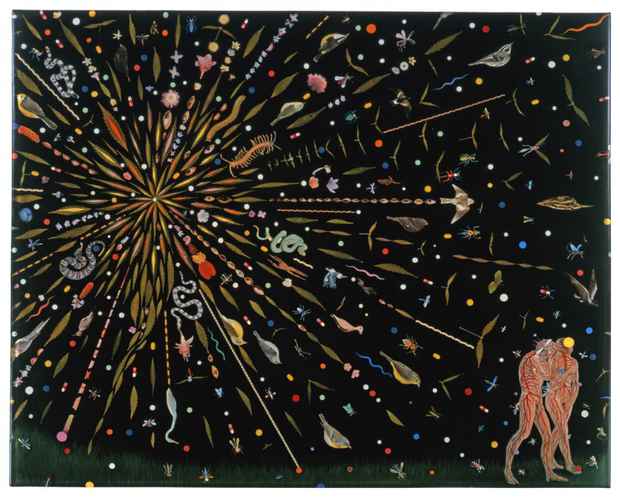“Back to Eden: Contemporary Artists Wander the Garden” Exhibition
Museum of Biblical Art

[Image: Fred Tomaselli "Study for Expulsion" (2000) Leaves, pills, acrylic, photocollage, and resin on wood panel 24 x 30 in. © The Artist / Courtesy of James Cohan Gallery, New York/Shanghai]
This event has ended.
“Back to Eden” looks at the biblical story of the Garden of Eden, and how it has directly and indirectly inspired contemporary artists. In particular, the exhibition considers the Garden of Eden as a lens through which to view the relationship between humans and the natural world.
Artists in the Western world have used elements of the Garden of Eden story for centuries as potent symbols: the Creation of plants and animals, the Tree of Knowledge and the Tree of Life, the Forbidden Fruit, the Serpent, the Fall of Man and the Expulsion from Eden. In this exhibition, contemporary artists continue to mine this rich resource for metaphors that are both personal and universal. Barnaby Furnas’s The Fruit Eaters takes the classic subject of Adam and Eve biting the apple, and renders it fresh and vital, with paint that seems to still be dripping, and a violent and malevolent serpent circling menacingly. Jim Dine’s Garden of Eden gate evokes happy childhood memories of his family’s tool store. Mark Dion, in a work created especially for this exhibition, presents a fantasy diorama of the serpent, imagining how he looked with legs, before he was cursed by God to crawl on his belly.
The garden has for centuries represented a perfect natural paradise that we have now lost. Several of the artists in the exhibition consider the ways in which humans have tried to recreate a “perfect garden.” Naomi Reis’s drawings of imaginary Modernist buildings are overlaid with lush plants and fountains that, like the Gardens of Babylon or the botanical gardens of Victorian times, show the attempt to recreate an exotic paradise within a completely foreign environment. In Lina Puerta’s installations, nature becomes the intruder, reinserting itself into the urban environment, intertwined with manmade sequins and buttons: a garden that is a mix of the natural and the manmade. Mary Temple’s garden appears as a shadow cast on a gallery wall, caused by light streaming through an imaginary window.
Theologians continue to debate about the environmental implications of the story of Genesis: does the environment fall under the dominion of humans, and have value primarily through its use by them? Or was the environment given to humans for their stewardship, and were they intended to nurture it? Marina Zurkow looks at the often-disastrous effects of the dominion/stewardship attitudes towards nature; through her animation of a dystopian Times Square reclaimed by nature. Alexis Rockman’s Gowanus similarly shows the evil results of manmade sewage on the natural environment in Brooklyn. These two artists bring the story of the Garden of Eden to MOBIA’s home in New York City, reminding us that we have the opportunity to both achieve and lose Paradise all over again, right where we are.
Media
Schedule
from June 27, 2014 to September 28, 2014
Artist(s)
Dana Sherwood, Sean Capone, Pipilotti Rist, Rona Pondick, Fred Tomaselli, Barnaby Furna, Jim Dine, Naomi Reis, Lina Puerta, Mark Dion, Mary Temple, Marina Zurkow, Alexis Rockman et al.